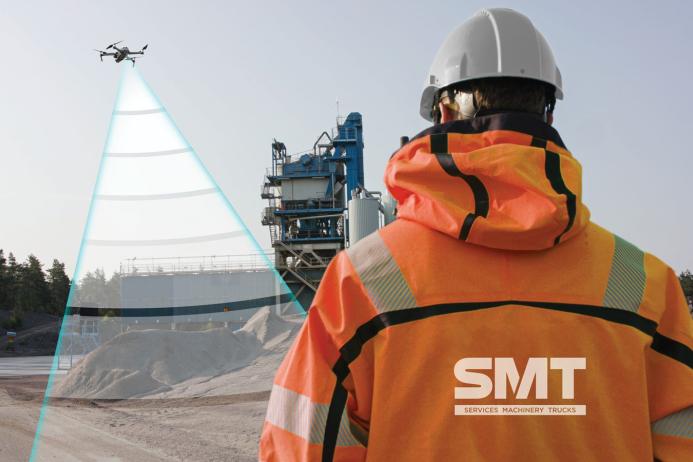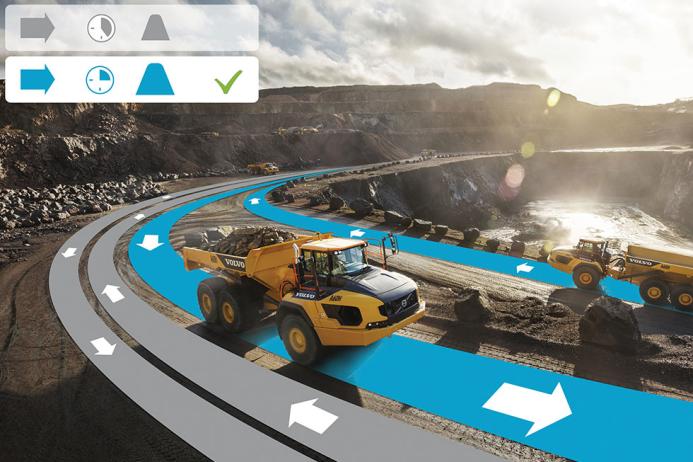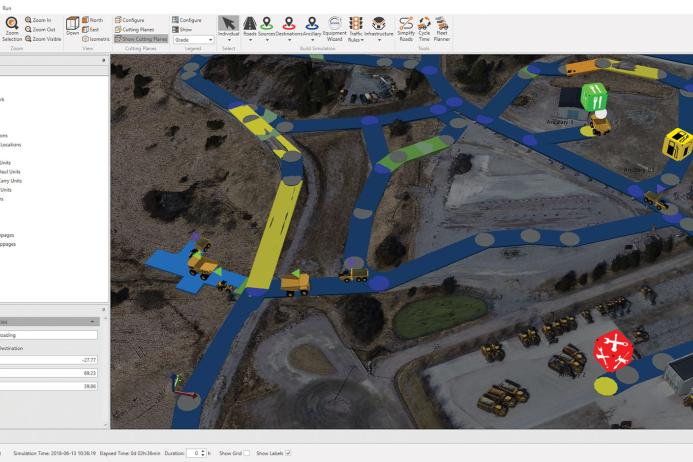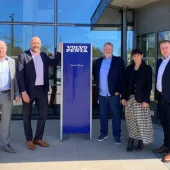SMT Site Simulation: Seeing the Bigger Picture

First published in the April 2023 issue of Quarry Management
Fleet optimization and tailored site design can result in increased productivity and reduced operating cost, as SMT GB’s Site Sim product manager, John Lawrence, explains
No site manager wants to see a fleet of trucks waiting to be loaded, or an excavator or loader standing idle as those trucks return along the haul road. Getting the mix of machines right for an individual site can be a complex process, taking into account a wide range of variables. Volvo Construction Equipment distributor SMT GB can help, with a variety of computer-based tools, including the latest version of the SMT Site Simulation program (Site Sim).
Volvo have offered a range of performance and productivity services to quarries and contractors for many years. This includes uptime services like ActiveCare and Oil Analysis, productivity services like Efficient Load Out, Connected Map and CO2 Reduction Program, and safety services such as Volvo Smart View and Pin Code Lock. The company also has a broad offer of fuel-efficiency services available to customers, including Fuel Efficiency Reports, Operator Training and SMT Site Simulation.
Site Sim is perhaps the most holistic service on offer, looking at a specific operation from every angle. It can be used to improve an existing site, or to plan new works before machines are delivered. This can incorporate everything from machine and bucket choice, to haul route and crusher processing design, using a host of operating criteria designed to reduce fuel use and cost per tonne moved.

Data collection
The first stage of the Site Sim process is the collection of data. This can be collated from traditional measurement methods, such as manual input from distance wheels, to more technologically advanced 3D GPS data that can be pulled from sensors on site vehicles or from engineer design software. SMT have at their disposal two surveying drones that are used to collect site information, which can be shown as high-resolution photography or in three-dimensional graphics. The company can also pull detailed operational data from existing machine telematics on site.
The SMT team will take into account specific jobsite-related data, such as bank density, swell factor of material, average bucket fill and ground conditions at different times of the year. A simulation of the operation can then be run, with a graphic 3D model of the site demonstrating loading, hauling or conveyors, crushing and screening operations. Indeed, multiple simulations can be run, each with a slight variable to assess the many options available to the site management team.
SMT include realistic working conditions, such as 55min operating hours to allow for machine movement and other factors that will slow or stop the equipment during the day. The team can then analyse the data, with the Site Sim software capable of running the operation with numerous outcomes.
They can change the size of hauler, or the number of trucks working with each excavator, to find the perfect match, depending on haul road length, bucket size and material density. Site Sim can alter bucket size, with or without quick-hitches, to better match the loading machine to the hauling solution. This can be carried out using the contractor or quarry owner’s existing plant and machinery fleet, or with new equipment to be supplied. SMT will not only work with Volvo machinery either. If the quarry has rigid trucks, for instance, or a conveyor system rather than mobile haulers, the data can be input from the manufacturer’s own literature, to calculate which solution would be the right fit for the site and the operating conditions.

Site analysis
The company is not simply looking to match the equipment to the existing site. By using the 3D graphic simulation of the quarry, SMT can suggest changes to haul road design and excavation areas that could reduce haul distances or improve machine productivity. At one location that has used the service, SMT were able to recommend a revision to the haul road layout that saved time and money for the quarry.
‘We analyse the data, we optimize the site and then we work with the customer,’ said John Lawrence, SMT GB’s Site Sim product manager. ‘We can simulate what will happen in the future and optimize what is happening now. It’s about how you use the information.’
SMT can pull a huge amount of information from the simulation programme, from tonnes moved per hour or per litre, to CO2 emissions and potential operating costs. All possible data is included, such as fuel burn, lubrication and maintenance costs over the life of the machinery, to give a complete picture of the potential savings that might be available.


Potential savings
While SMT would obviously like to provide fleets with a range of new Volvo equipment as a result of the simulation, an increasing number of larger quarry operators are employing the analysis as a standalone product. With the Site Sim team taking around 4–5 days to measure, collate and analyse the data, the cost of service can soon be recouped against improved productivity, reduced fuel burn and lower cost per tonne moved, even with existing equipment.
Being able to demonstrate how different types of equipment, larger or smaller, would affect productivity on site, without having to actually install and work that equipment, can be an invaluable aid when planning extensions to site, or when looking for savings and increased operational efficiency.
Site Sim is not only a useful tool for quarry operators. It can be equally effective when planning major earthmoving sites or in operations such as waste handling and recycling. Any site that has a fleet of equipment working over a regular haul can benefit from the analysis. Nor is the technology restricted to massive fleets of machinery. Smaller operations that have repeatable working can also benefit from the Site Sim tool.
‘We’re very focused on this,’ said Mr Lawrence. ‘We have all sorts of technology available, but when you have a solution that is based on technology, everyone joining along that road is potentially at a different place. That’s why consultation with the customer is vital.’
Potential customers can find out more through their local SMT GB contact and the company will be demonstrating Site Sim at both the Plantworx exhibition in June and the upcoming Digital Construction Week at ExCeL London in May.
Subscribe to Quarry Management, the monthly journal for the mineral products industry, to read articles before they appear on Agg-Net.com








